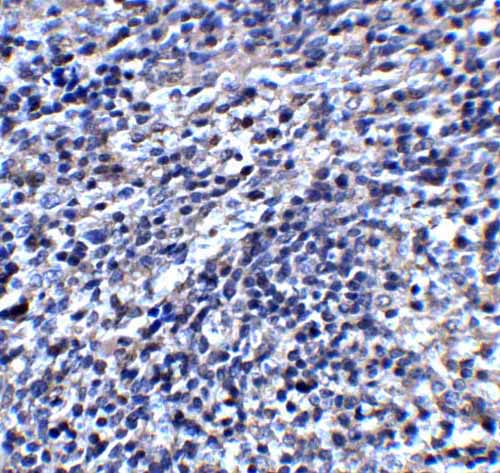S1PR2 Antibody
- SPECIFICATION
- CITATIONS
- PROTOCOLS
- BACKGROUND

Application
| WB, IHC-P, IF, E |
|---|---|
| Primary Accession | O95136 |
| Other Accession | NP_004221, 9294 |
| Reactivity | Human, Mouse, Rat |
| Host | Rabbit |
| Clonality | Polyclonal |
| Isotype | IgG |
| Calculated MW | Predicted: 39 kDa Observed: 50 kDa |
| Application Notes | S1PR2 antibody can be used for detection of S1PR2 by Western blot at 1 - 2 μg/ml. Antibody can also be used for immunohistochemistry at 10 μg/ml. |
| Gene ID | 9294 |
|---|---|
| Target/Specificity | S1PR2 antibody was raised against an 16 amino acid peptide near the carboxy terminus of human S1PR2. The immunogen is located within amino acids 270 - 320 of S1PR2. |
| Reconstitution & Storage | S1PR2 antibody can be stored at 4℃ for three months and -20℃, stable for up to one year. |
| Precautions | S1PR2 Antibody is for research use only and not for use in diagnostic or therapeutic procedures. |
| Name | S1PR2 |
|---|---|
| Synonyms | EDG5 |
| Function | Receptor for the lysosphingolipid sphingosine 1-phosphate (S1P) (PubMed:10617617, PubMed:25274307). S1P is a bioactive lysophospholipid that elicits diverse physiological effects on most types of cells and tissues (PubMed:10617617). When expressed in rat HTC4 hepatoma cells, is capable of mediating S1P-induced cell proliferation and suppression of apoptosis (PubMed:10617617). Receptor for the chemokine-like protein FAM19A5 (PubMed:29453251). Mediates the inhibitory effect of FAM19A5 on vascular smooth muscle cell proliferation and migration (By similarity). In lymphoid follicles, couples the binding of S1P to the activation of GNA13 and downstream inhibition of AKT activation leading to suppression of germinal center (GC) B cell growth and migration outside the GC niche. |
| Cellular Location | Cell membrane; Multi-pass membrane protein |

Thousands of laboratories across the world have published research that depended on the performance of antibodies from Abcepta to advance their research. Check out links to articles that cite our products in major peer-reviewed journals, organized by research category.
info@abcepta.com, and receive a free "I Love Antibodies" mug.
Provided below are standard protocols that you may find useful for product applications.
Background
The Sphingosine 1-phosphate receptor 2 (S1PR2) protein was initially identified as G-protein coupled receptor thought to be involved in development (1) and was found to mediate sphingosine 1-phosphate (SPP)-induced cell rounding and neurite retraction (2). S1PR2 and the related protein S1PR3 (also known as EDG3) are also thought to mediate the SPP-induced cell proliferation, survival, and related signaling events (3). S1PR2 has also been found to be key regulator in acute vascular inflammation and may be a novel therapeutic target for vascular disorders (4).
References
MacLennan AJ, Browe CS, Gaskin AA, et al. Cloning and characterization of a putative G-protein coupled receptor potentially involved in development. Mol. Cell Neurosci. 1994; 5:201-9.
Van Brocklyn JR, Tu Z, Edsall LC, et al. Sphingosine 1-phosphate-induced cell rounding and neurite retraction are mediated by the G protein-coupled receptor H218. J. Biol. Chem. 1999; 274:4626-32.
An S, Zheng Y, and Bleu T. Sphingosine 1-phosphate-induced cell proliferation, survival, and related signaling events mediated by G protein-coupled receptors Edg3 and Edg5. J. Biol. Chem. 275:288-96.
Zhang G, Yang L, Kim GS, et al. Critical role of sphingosine-1-phosphate receptor 2 (S1PR2) in acute vascular inflammation. Blood 2013; 122:443-55.
If you have used an Abcepta product and would like to share how it has performed, please click on the "Submit Review" button and provide the requested information. Our staff will examine and post your review and contact you if needed.
If you have any additional inquiries please email technical services at tech@abcepta.com.













 Foundational characteristics of cancer include proliferation, angiogenesis, migration, evasion of apoptosis, and cellular immortality. Find key markers for these cellular processes and antibodies to detect them.
Foundational characteristics of cancer include proliferation, angiogenesis, migration, evasion of apoptosis, and cellular immortality. Find key markers for these cellular processes and antibodies to detect them. The SUMOplot™ Analysis Program predicts and scores sumoylation sites in your protein. SUMOylation is a post-translational modification involved in various cellular processes, such as nuclear-cytosolic transport, transcriptional regulation, apoptosis, protein stability, response to stress, and progression through the cell cycle.
The SUMOplot™ Analysis Program predicts and scores sumoylation sites in your protein. SUMOylation is a post-translational modification involved in various cellular processes, such as nuclear-cytosolic transport, transcriptional regulation, apoptosis, protein stability, response to stress, and progression through the cell cycle. The Autophagy Receptor Motif Plotter predicts and scores autophagy receptor binding sites in your protein. Identifying proteins connected to this pathway is critical to understanding the role of autophagy in physiological as well as pathological processes such as development, differentiation, neurodegenerative diseases, stress, infection, and cancer.
The Autophagy Receptor Motif Plotter predicts and scores autophagy receptor binding sites in your protein. Identifying proteins connected to this pathway is critical to understanding the role of autophagy in physiological as well as pathological processes such as development, differentiation, neurodegenerative diseases, stress, infection, and cancer.


